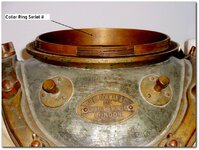Narked1
Full Member
Not sure where to post this, so webmasters please help out if this isn't the correct forum. Was out and about in town today (Alexandria, Egypt) picking up some supplies for work when I came across a diving helmet from Siebe & Gorman Submarine Engineers out of London. Have done some research online on Siebe and Gorman and know that the helmet is pre-1941. In 1941 the factory in London was destroyed by German bombing and much of the history of the company was lost forever.
What I am looking for here is help in identifying various models of the Siebe & Gorman diving helmets. The helmets that I have seen online all have the air connection on the right-hand side with external piping on the outside of the helmet running up about 3-4 inches before entering the helmet itself. The one that I have found does not have the external piping, only having a direct connection between the hose and the helmet which leads me to believe that this may be a much older 12 bolt model. Also, where it is fastened to the diver's suit, there are 6 separate metal straps. The ones that I have seen on-line all appear to be one piece, again indicating an earlier model.
Will get the serial numbers off of the helmet tomorrow and a couple of pictures to post. Lastly, this helmet appears to be in better condition than anything that I have seen online so far (which may mean that it could also be a newer model as well), just needs a lot of cleaning.
If anyone has information on the various models of the Siebe and Gorman diving helmets, and/or information on early open-circuit diving in Egypt (1850-1940) it would be greatly appreciated.
Would make a nice museum piece in my living room, old or not.
Mike
What I am looking for here is help in identifying various models of the Siebe & Gorman diving helmets. The helmets that I have seen online all have the air connection on the right-hand side with external piping on the outside of the helmet running up about 3-4 inches before entering the helmet itself. The one that I have found does not have the external piping, only having a direct connection between the hose and the helmet which leads me to believe that this may be a much older 12 bolt model. Also, where it is fastened to the diver's suit, there are 6 separate metal straps. The ones that I have seen on-line all appear to be one piece, again indicating an earlier model.
Will get the serial numbers off of the helmet tomorrow and a couple of pictures to post. Lastly, this helmet appears to be in better condition than anything that I have seen online so far (which may mean that it could also be a newer model as well), just needs a lot of cleaning.
If anyone has information on the various models of the Siebe and Gorman diving helmets, and/or information on early open-circuit diving in Egypt (1850-1940) it would be greatly appreciated.
Would make a nice museum piece in my living room, old or not.
Mike








 Merry Christmas to all from Egypt.
Merry Christmas to all from Egypt.
